Balancing bitter herbs in your tea blends is essential for creating a delightful and harmonious flavor profile. You want the bitterness to enhance, not overpower, your tea. By carefully measuring the amount of bitter herbs, like dandelion or gentian, you can achieve a more complex taste that invites you to savor each sip. It also improves aroma and increases the health benefits, making your tea experience more enjoyable. Plus, a well-balanced blend attracts a wider audience to your flavors. If you explore further, you'll discover tips on blending techniques and how to enhance your tea experience even more.
Understanding Bitter Herbs

Understanding bitter herbs is essential for creating well-balanced tea blends. These herbs, often overlooked, play an important role in the overall flavor profile of your tea. When you incorporate bitter herbs, you introduce complexity and depth, enhancing the drinking experience. Common bitter herbs include dandelion, gentian, and wormwood, each offering unique characteristics that can elevate your blend.
When selecting bitter herbs, pay attention to their potency. A little goes a long way; too much bitterness can overpower other flavors and leave your tea unpalatable. Start by adding small amounts, then adjust according to your taste preferences.
It's also critical to take into account the other ingredients in your blend. Sweet and floral components can help balance the bitterness, creating a harmonious flavor profile.
Experimenting with different combinations will help you discover what works best for you. Keep a journal of your blends to track which combinations you enjoy most.
Benefits of Balancing Flavors
Balancing flavors in your tea blends is essential for creating a satisfying experience. When you carefully balance the bitterness of herbs with other flavors, you enhance the overall taste, making it more enjoyable. A harmonious blend invites you to savor each sip, rather than overwhelming your palate with one dominant note.
Here's a quick overview of the benefits of balancing flavors in your tea:
| Benefit | Description |
|---|---|
| Enhanced Palate Experience | A balanced blend guarantees a pleasant taste journey. |
| Improved Aroma | Different flavors can create a more inviting aroma. |
| Increased Health Benefits | Combining flavors can enhance the therapeutic effects. |
| Broader Appeal | A diverse flavor profile attracts a wider audience. |
Common Bitter Herbs in Blends
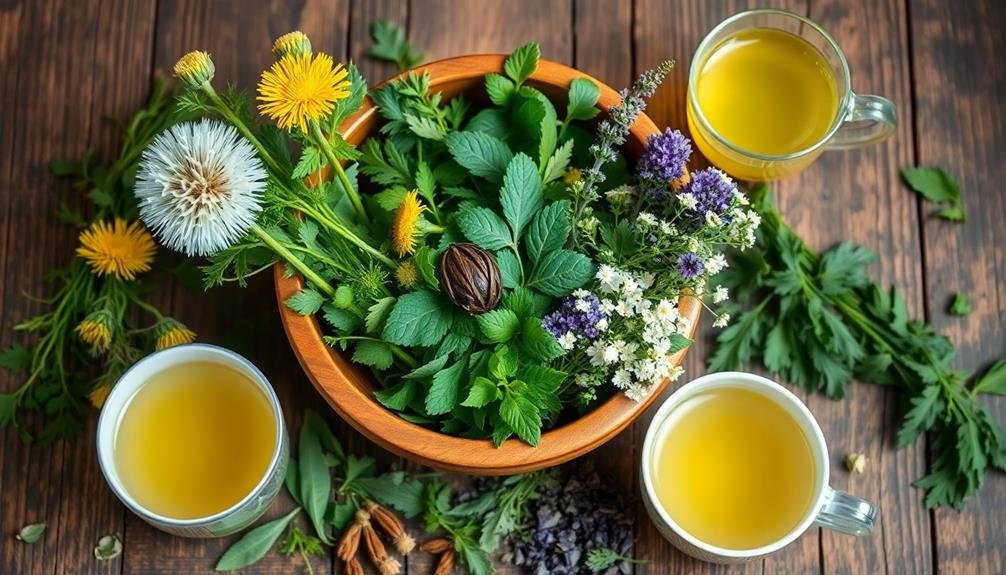
Bitter herbs play a crucial role in tea blends, bringing depth and complexity to the flavor profile. When you explore different combinations, you'll often encounter several common bitter herbs that can elevate your tea experience.
One popular choice is dandelion root, which offers a robust, earthy taste and is known for its digestive benefits. Another favorite is gentian root, renowned for its intense bitterness and medicinal properties, making it a staple in herbal blends.
You might also consider adding wormwood, which has a sharp, pungent flavor and adds a unique touch to your tea. If you're looking for something a bit milder, chicory root can provide a subtle bitterness while contributing a nutty undertone.
Hibiscus, while primarily sour, can also impart a gentle bitterness that balances out sweeter ingredients.
Finally, consider using golden seal; its strong, bitter taste is often used in traditional herbal remedies.
Recommended Blending Ratios
When crafting your tea blends, finding the right ratios of bitter herbs to other ingredients is key for achieving a harmonious flavor. You don't want the bitterness to overpower the other elements, but you also want it to shine through.
A good starting point is to use bitter herbs in moderation. Consider these recommended blending ratios:
- Bitter herbs: 10-20% of the total blend
- Sweet herbs: 30-50% to balance the bitterness
- Aromatic herbs/spices: 20-30% for added depth
- Base herbs: 20-30% to provide a solid foundation
These ratios can vary based on the specific herbs you choose and your personal taste preferences. Start small, and adjust as needed.
Remember, the goal is to create a blend that's enjoyable and has a pleasant complexity. You might find that certain bitter herbs work better with specific sweet or aromatic components, so don't hesitate to experiment.
Keep a record of your blends to refine your ratios over time, ensuring you create the perfect balance that suits your palate. Happy blending!
Techniques for Flavor Harmony
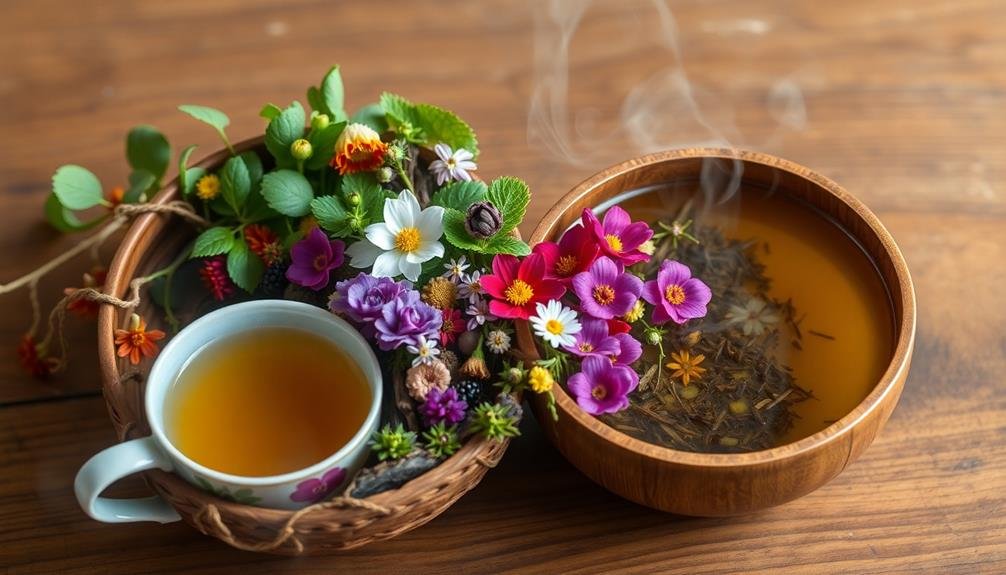
Creating flavor harmony in your tea blends requires a keen understanding of how different herbs interact with each other. Start by identifying the dominant flavor profiles of each herb you plan to use. Consider whether the herbs are sweet, bitter, floral, or earthy, and think about how these characteristics will play together in your blend.
Next, experiment with complementary flavors. For instance, if you're using a bitter herb like dandelion root, balance it with sweet herbs such as licorice or vanilla bean. This contrast can help soften the bitterness while enhancing the overall taste.
Don't forget about texture and aroma. Adding herbs like mint or citrus peel can introduce invigorating notes that cut through heaviness.
Also, think about the brewing time and temperature, as these factors can greatly affect the extraction of flavors.
Enhancing Your Tea Experience
To truly enhance your tea experience, consider the flavor complexity that well-balanced blends can offer.
You'll not only enjoy a richer taste but also reap various health benefits when the ingredients work in harmony.
Plus, the aroma and sensory experience can elevate your tea time from ordinary to extraordinary.
Flavor Complexity in Blends
As you explore the world of tea blends, you'll quickly discover that flavor complexity is key to enhancing your experience. A well-balanced blend can elevate your tea-drinking pleasure, making it a sensory journey.
The interplay of flavors can surprise your palate and keep every sip interesting.
To achieve this complexity, consider these elements when crafting your blends:
- Contrast: Pair bitter herbs with sweet or floral notes to create a harmonious balance.
- Depth: Incorporate layers of flavors, such as citrus or spice, to add richness and intrigue.
- Texture: Think about the mouthfeel; combining smooth and crisp elements can enhance your overall experience.
- Aroma: Don't overlook the power of scent; aromatic herbs can set the stage for the flavor profile.
Health Benefits of Balance
While you may savor the flavors of your tea blend, the balance of ingredients also plays an essential role in promoting your overall well-being. A well-balanced tea can enhance your health by combining the benefits of various herbs. For instance, bitter herbs can aid digestion and detoxification, while sweeter or milder ingredients can offset their intensity, making the experience more enjoyable.
When you create harmony among your tea components, you not only improve taste but also amplify the health benefits. Balanced blends can support your immune system, reduce inflammation, and boost energy levels.
If you're feeling stressed, the right combination can promote relaxation and mental clarity, helping you tackle your day with vigor.
Moreover, a balanced tea blend guarantees that you're not overwhelmed by any single herb's properties. This encourages you to sip and savor your tea regularly, integrating it into your daily routine.
Aroma and Sensory Experience
The aroma of your tea plays an essential role in shaping your overall experience, making each sip not just a moment of enjoyment but a sensory journey.
When you brew your tea, the fragrant notes wafting through the air set the stage for what's to come. Balancing bitter herbs with aromatic elements can elevate your tasting experience, allowing you to fully appreciate the complexity of flavors.
To enhance your tea experience, consider these aspects:
- Herb Selection: Choose bitter herbs that complement the fragrance of your tea, creating a harmonious blend.
- Brewing Temperature: Adjusting the temperature can influence the aroma, revealing different scent profiles.
- Timing: Steeping for the right amount of time guarantees you capture the full essence without overwhelming bitterness.
- Serving Ceremony: Engage your senses by preparing and serving tea mindfully, taking in the visual and aromatic details.
Frequently Asked Questions
Can I Use Fresh Bitter Herbs Instead of Dried Ones?
You can definitely use fresh bitter herbs instead of dried ones! Just remember that fresh herbs are more potent, so you might need to adjust the quantity to achieve your desired flavor balance in your tea blend.
How Do I Know if My Blend Is Too Bitter?
You'll know your blend's too bitter if it overwhelms your palate, leaving a harsh aftertaste. Taste it gradually, and if the bitterness distracts from other flavors, consider adjusting with sweeter or milder herbs to balance.
Are There Specific Herbs to Avoid When Blending?
When blending, avoid overly bitter herbs like wormwood or dandelion root if you're aiming for a balanced flavor. Instead, focus on milder herbs like chamomile or peppermint to create a more enjoyable tea experience.
How Long Do Bitter Herbs Last in Tea Blends?
Bitter herbs typically last about six months in tea blends if stored properly. Keep them in a cool, dark place in airtight containers to maintain their flavor and potency for the best brews.
Can I Combine Bitter Herbs With Sweeteners Effectively?
Yes, you can combine bitter herbs with sweeteners effectively. Just experiment with different sweeteners to find the right balance, enhancing the flavors while maintaining the health benefits of the bitter herbs in your tea blends.
In Summary
Balancing bitter herbs in your tea blends isn't just about taste; it enhances the overall experience. By understanding the benefits of these herbs and knowing how to blend them effectively, you can create a harmonious cup that delights your senses. Experiment with different ratios and techniques to find what works best for you. Remember, the right balance can transform your tea time into a soothing ritual that promotes both flavor and wellness. Enjoy your brewing journey!


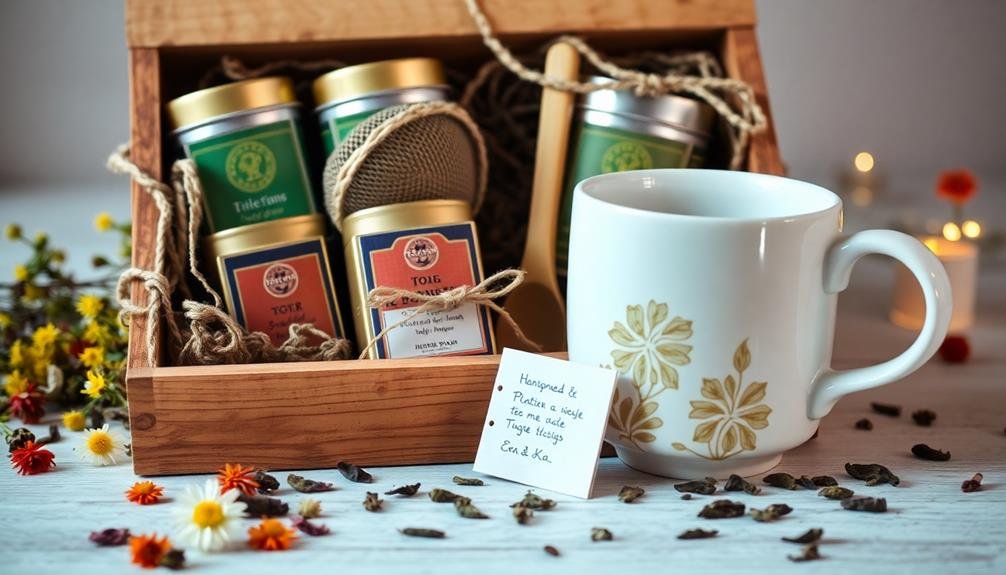
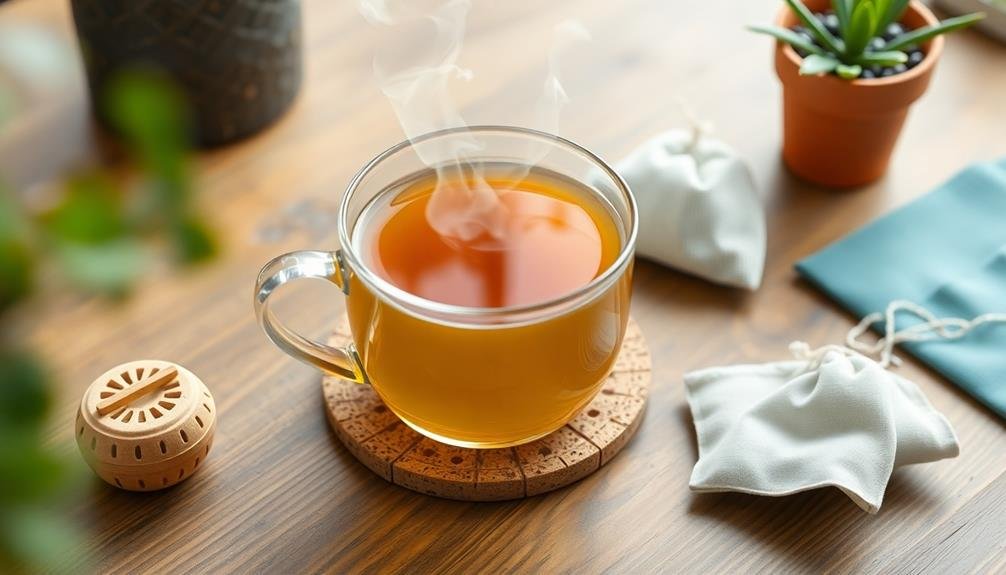
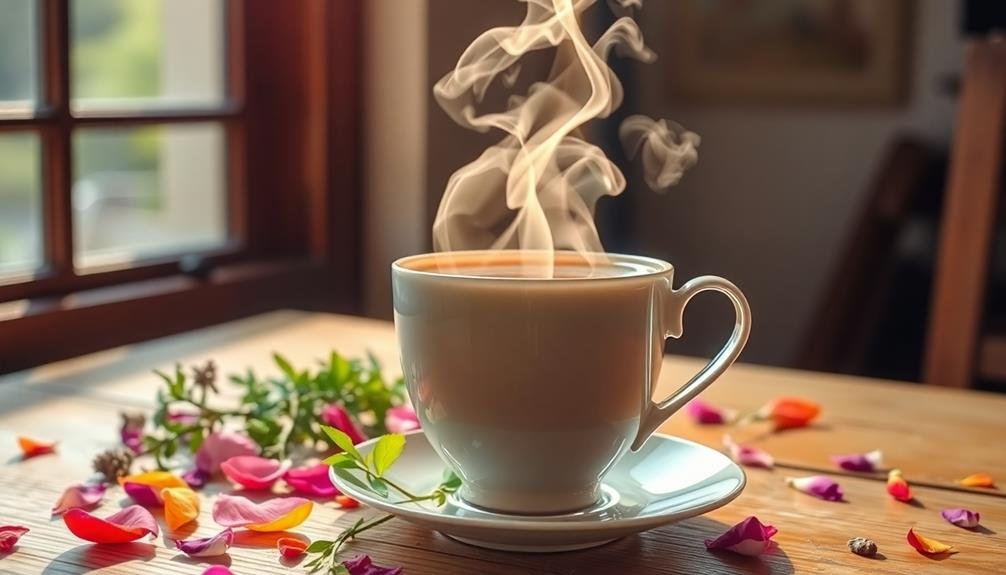
Leave a Reply